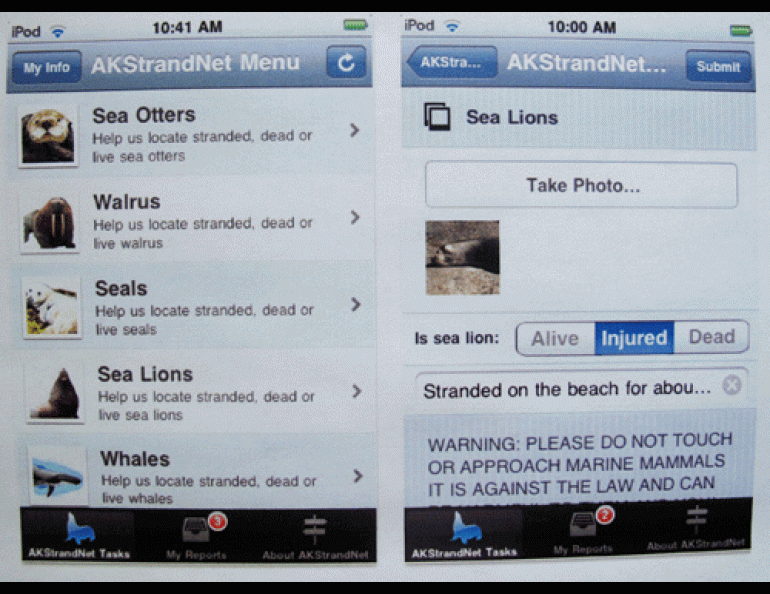
Cellphones as citizen-science tools
“Found Sea Otters Dead at 3851 Homer Spit Road . . . Right in front of oyster facility.”
Verena Gill was thrilled when this message appeared on her iPhone on a recent Saturday afternoon; it was the first use of a new iPhone application that allows people to report a beached marine mammal.
Gill, a biologist who studies sea otters and other marine mammals in her job with the U.S. Fish and Wildlife Service in Anchorage, helped develop the free iPhone application. It allows anyone with an iPhone to report stranded whales, walruses, seals, sea lions and sea otters.
People with the application on their cellphones can take photos of the dead or live animals and write a short description of the scene. The photo records the latitude and longitude of the animal, and the application sends an email to a network of biologists, veterinarians and others who scramble into action to recover the animal or examine it at the site. That team includes people from National Marine Fisheries Service, the U.S. Fish and Wildlife Service, the Alaska SeaLife Center in Seward, and volunteers throughout coastal Alaska.
“Sometimes that means a veterinarian, pathologist and a biologist jumping on a plane and heading to Glacier Bay to look at a whale,” Gill said.
The cellphone application is a new tool in an established network of wildlife experts who mobilize when there’s a telephone or email report of a marine mammal washed up on Alaska’s coast. If an animal is injured, sometimes veterinarians rehabilitate it at the SeaLife Center in Seward. More often, people report dead animals, which are “a goldmine of information,” Gill said.
“We learn a lot from them,” she said. “Absolutely.”
She said the Anchorage office of the Fish and Wildlife Service receives about 100 sea otter carcasses a year.
“We have a pretty strong necropsy program up here,” she said. “Sea otters are easy to transport to the lab, and they eat the same things that we do, like clams and crabs. They can really tell us what’s going on.”
Technicians in the lab dissect otters and other marine mammals to try and find out how the animals died.
“One of the leading causes of (sea otter) death are boat strikes — who knew?” Gill said.
The brand-new iPhone application, available here (http://itunes.apple.com/us/app/akstrandnet/id383326791?mt=8), was Gill’s idea. She had seen a similar application that allowed people to report oiled wildlife, tar balls and oily sheens resulting from the recent Gulf of Mexico oil spill. She found the responsible computer experts at the University of Massachusetts Amherst and asked them if they would help her create an Alaska application. Deepak Ganean and Mohamed Musthag not only helped her, they did it for free.
“People will be able to be on the spot, and all they have to do is just take a photo,” Gill said. “The photo will give us the lat/long and we’ll go from there.”
When people activate the application, their phone will send an email to Gill and the Alaska SeaLife Center.
“I would love everybody who lives on the Alaska coast and has an iPhone to have the application,” Gill said. “We’re hoping that people who go on holiday in Alaska will download it. It’s an experiment. We’ll see how it works.”





